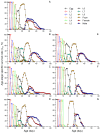Effects of Multi-Generational Rearing on Job's Tears on the Performance and Host Plant Preference of Spodoptera frugiperda (Lepidoptera: Noctuidae)
- PMID: 40870574
- PMCID: PMC12386935
- DOI: 10.3390/insects16080773
Effects of Multi-Generational Rearing on Job's Tears on the Performance and Host Plant Preference of Spodoptera frugiperda (Lepidoptera: Noctuidae)
Abstract
The fall armyworm (FAW), Spodoptera frugiperda, is a highly polyphagous pest posing a major threat to Poaceae crops, particularly corn (Zea mays), in China. However, its ability to adapt to Job's tears (Coix lacryma-jobi), an edible and medicinal Poaceae species, under continuous rearing remains insufficiently understood. In this study, FAW survival, development, and reproduction were assessed over eight generations on two cultivars of Job's tears, 'Cuiyi 1' and 'Puyi 6'. Feeding and oviposition preferences were also examined in FAW populations reared on 'Puyi 6' by offering corn and 'Puyi 6' as hosts. Sustained rearing for five to eight generations on both cultivars significantly increased population fitness, with greater improvements observed in the 'Puyi 6' group. FAW reared on corn or 'Puyi 6' for two generations exhibited strong preferences for corn, whereas those reared on 'Puyi 6' for five to eight generations showed no significant host preference. These findings suggest that transgenerational adaptation markedly improved FAW performance and acceptance of Job's tears, underscoring the need for intensified monitoring of FAW dynamics during the cultivation of Job's tears.
Keywords: Coix lacryma-jobi; Zea mays; acclimation; fall armyworm; host plant adaptation; life table; population projection.
Conflict of interest statement
The authors declare no conflicts of interest.
Figures







Similar articles
-
Effects of continuous and transgenerational rearing in peanut leaves on the performance and enzyme activity of Spodoptera frugiperda (Lepidoptera: Noctuidae).J Econ Entomol. 2024 Dec 28;117(6):2259-2268. doi: 10.1093/jee/toae230. J Econ Entomol. 2024. PMID: 39425904
-
Performance of the Fall Armyworm, Spodoptera frugiperda (Lepidoptera: Noctuidae), over Three Generations on Four Maize Cultivars.Insects. 2025 Jul 12;16(7):719. doi: 10.3390/insects16070719. Insects. 2025. PMID: 40725349 Free PMC article.
-
Comparative analysis of Spodoptera frugiperda (J. E. Smith) (Lepidoptera, Noctuidae) corn and rice strains microbiota revealed minor changes across life cycle and strain endosymbiont association.PeerJ. 2024 Apr 12;12:e17087. doi: 10.7717/peerj.17087. eCollection 2024. PeerJ. 2024. PMID: 38623496 Free PMC article.
-
Physical exercise training interventions for children and young adults during and after treatment for childhood cancer.Cochrane Database Syst Rev. 2016 Mar 31;3(3):CD008796. doi: 10.1002/14651858.CD008796.pub3. Cochrane Database Syst Rev. 2016. PMID: 27030386 Free PMC article.
-
Falls prevention interventions for community-dwelling older adults: systematic review and meta-analysis of benefits, harms, and patient values and preferences.Syst Rev. 2024 Nov 26;13(1):289. doi: 10.1186/s13643-024-02681-3. Syst Rev. 2024. PMID: 39593159 Free PMC article.
References
-
- Kenis M., Benelli G., Biondi A., Calatayud P.-A., Day R., Desneux N., Harrison R.D., Kriticos D., Rwomushana I., van den Berg J., et al. Invasiveness, biology, ecology, and management of the fall armyworm, Spodoptera frugiperda. Entomol. Gen. 2023;43:187–241. doi: 10.1127/entomologia/2022/1659. - DOI
-
- Goergen G., Kumar P.L., Sankung S.B., Togola A., Tamò M. First report of outbreaks of the fall armyworm Spodoptera frugiperda (J E Smith) (Lepidoptera, Noctuidae), a new alien invasive pest in West and Central Africa. PLoS ONE. 2016;11:e0165632. doi: 10.1371/journal.pone.0165632. - DOI - PMC - PubMed
-
- Maruthadurai R., Ramesh R. Occurrence, damage pattern and biology of fall armyworm, Spodoptera frugiperda (J.E. smith) (Lepidoptera: Noctuidae) on fodder crops and green amaranth in Goa, India. Phytoparasitica. 2020;48:15–23. doi: 10.1007/s12600-019-00771-w. - DOI
-
- Jiang Y.Y., Liu J., Xie M.C., Li Y.H., Yang J.J., Zhang M.L., Qiu K. Observation on law of diffusion damage of Spodoptera frugiperda in China in 2019. Plant Prot. 2019;45:10–19. doi: 10.16688/j.zwbh.2019539. (In Chinese) - DOI
-
- Sun X.-X., Hu C.-X., Jia H.-R., Wu Q.-L., Shen X.-J., Zhao S.-Y., Jiang Y.-Y., Wu K.-M. Case study on the first immigration of fall armyworm, Spodoptera frugiperda invading into China. J. Integr. Agric. 2021;20:664–672. doi: 10.1016/S2095-3119(19)62839-X. - DOI
Grants and funding
LinkOut - more resources
Full Text Sources

